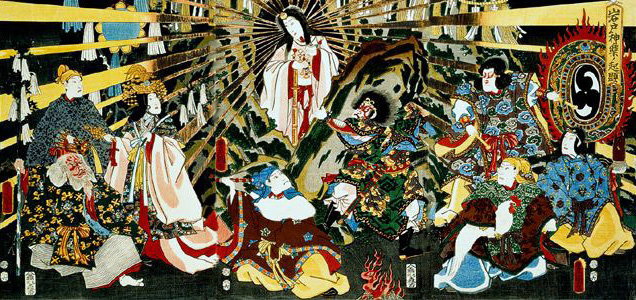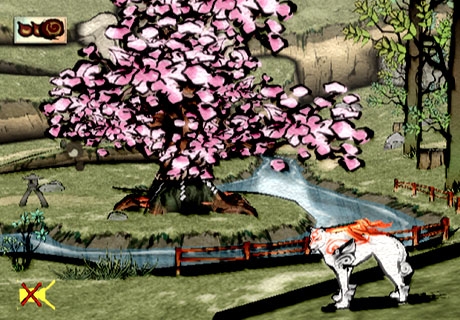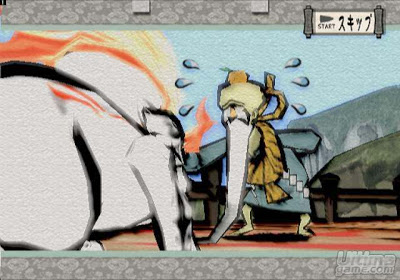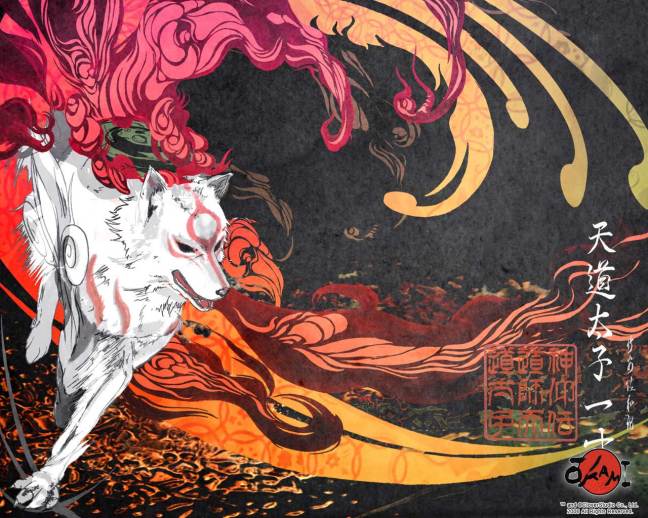Okami really was a unique game; it drew you into an epic Legend of Zelda like quest through a world of Japanese myth, rendered in a stunning visual style to make all the inhabitants look like they jumped straight out of a traditional water painting. But it’s not just the game that’s wonderful; it’s the fascinating use of Japanese myth which makes it a brilliant experience. This week we look who Amaterasu really was, why was she associated with wolves, and what was the inspiration behind our canine protagonist. If you’re not all that familiar with the game, then that’s fine, as we’ll learn a little bit about Shintoism and Japanese fairy tale.
Amaterasu

Amaterasu is the most central figure of the Shinto religion. The Sun is always a really important part of any religious mythology and Amaterasu is one of the only examples of a female being given the exulted role of sun deity.
It is from her divine lineage that the Emporors of ancient Japan used to support their claim of divinity and divine right to the throne. However, although there are a number of myths surrounding her, none of them have anything to do with a wolf. Which brings us onto the next question…
Why is Amaterasu a wolf?
The real question should be ‘what excuse did the game makers use to portray the Shinto sun Goddess as a wolf?’ Well, traditionally Amaterasu does not have anything to do with wolves, and though a sacred animal, wolves are not the most prominent creature in Japanese mythology. The reasoning (or rather excuse) that they used to make Amaterasu a wolf is explained in this Quora article:
Amaterasu is called Amaterasu-ōmikami(天照大神) which means the Great God(dess) Who Shines A Light From the Heavens. The 大神 part can be read a ōkami (oh-kami), which is the same reading as the word for wolf, 狼. It’s believed that the reading for the kanji 狼 does come from the word 大神 which means ‘great god(dess)’
This gave the creators the perfect wordplay to justify making the sun Goddess a wolf. The real reason they made her a wolf is because they wanted to use a wolf as part of game play and because there are a few interesting myths surrounding dogs in Japan, and a wolf is a more powerful form of a dog. Most of Ammy’s wolfish traits are inspired by the Japanese fairytale ‘The Old Man who made Withered Trees to Flower’, a story the creators would have grown up with the same way we grew up with Sleeping Beauty.
Mr Orange and The Man who made the Withered Trees to Flower
 I spoke about this story briefly in a previous article about being too nice in fairytales. Mr Orange’s dance and the importance of Ammy’s ability to make cherry blossoms bloom all come from this Japanese fairytale. It centers around an old man who owns a dog called Shiro (maybe this influenced the name Shiranui?) because: ‘Shiro means “white”, and he was called so because of his color. He was a real Japanese dog, and very like a small wolf in appearance.’ I think we can see that Shiro is more the influence behind our four legged friend than the sun goddess Amaterasu.
I spoke about this story briefly in a previous article about being too nice in fairytales. Mr Orange’s dance and the importance of Ammy’s ability to make cherry blossoms bloom all come from this Japanese fairytale. It centers around an old man who owns a dog called Shiro (maybe this influenced the name Shiranui?) because: ‘Shiro means “white”, and he was called so because of his color. He was a real Japanese dog, and very like a small wolf in appearance.’ I think we can see that Shiro is more the influence behind our four legged friend than the sun goddess Amaterasu.
In this myth, the old couple who own Shiro have a very jealous neighbor. One day, Shiro digs under a yenoki tree and finds a heap of valuable coins (like how Ammy can tig up treasure in the game). The old couple are overjoyed, but the scheming neighbor is jealous. The old neighbour asks the old man to borrow his dog, and because the old man has all the spine of a jelly fish and would rather lend his dog to an abuser than cause a fuss and grow a backbone, he acquiescences. Of course, when Shiro digs up a pile of refuse instead of gold

(symbolising the state of the neighbor’s soul), the neighbour loses it and kills the dog and buries him beneath his yenoki tree. When the old man finds out, he asks for the neighbour’s yenoki tree and proceeds to cut it down to make a mortar. The mortar produces eternal rice cakes and again the neighbour borrows it and it doesn’t work, thought his time the elderly neighbour chops up the mortar and makes firewood.
This time, the old man asks for the ashes of the firewood, and he scatters them on his own yenoki tree. Surprisingly, it causes it to burst into full bloom and the old man gains a talent for it.
He is eventually called in by a Daimo (an earl) and is tasked with making his withered tree bloom. He acquiences and is rewarded. The neighbour tries the same but is humiliated and justly punished.
Clearly, this is the inspiration behind Amaterasu and her two most basic spells from the paint brush; the sun comes from Amaterasu’s connection with the Shinto Goddess; meanwhile, her ability to make the ccherry blossoms bloom comes from the fairytale of Shiro the dog and the old man. But Amaterasu isn’t the only character loosely based on Shinto mythology.
Next time, we’ll look at the other central figure of this game: Susanoo. We’ll explore the mythology behind the eight headed dragon, as well as Kushi and her magic sake. If you haven’t read it already, in part one we looked at the secret sparrow kingdom and the moon people, you can check it out by following this link.



